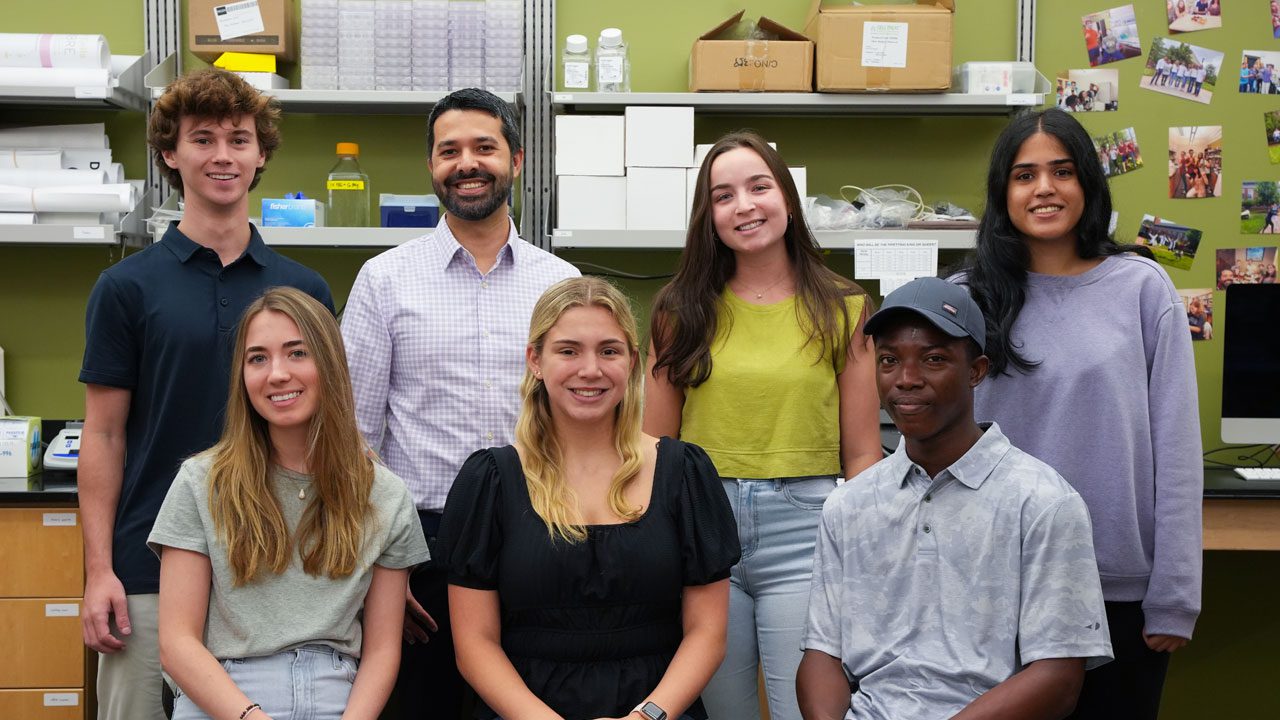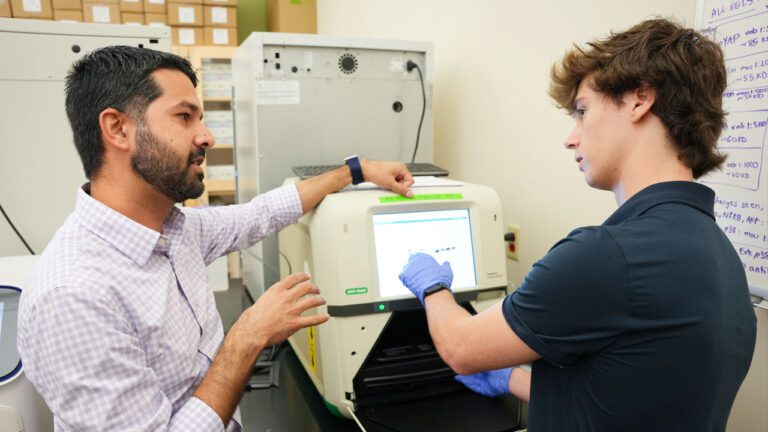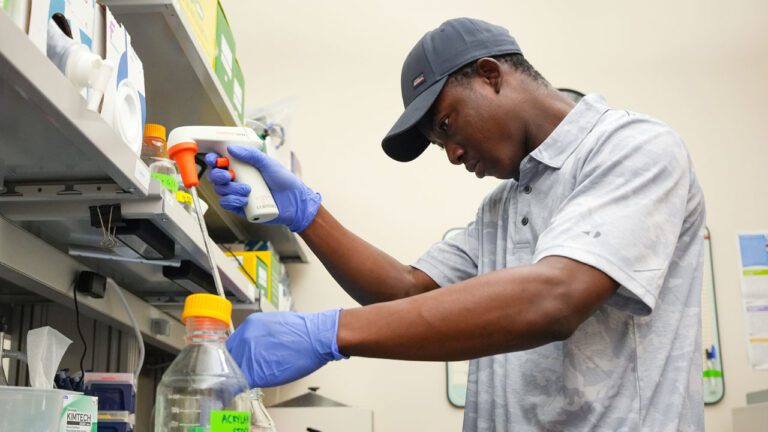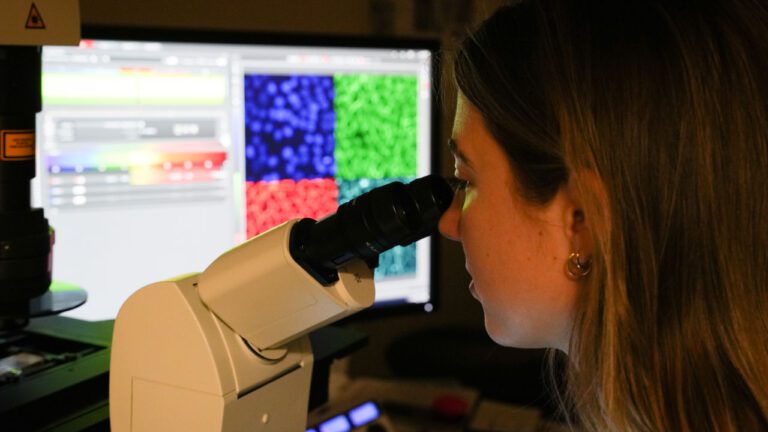of the university
Cells on the Move


Charlie Swiersz ’25 consults with Dubash.
When Adi Dubash, an associate professor of biology at Furman, started his lab in 2015, researchers had already shown that the complexes known as desmosomes were important for attaching cells to one another and giving tissues their structure. There was also evidence, though, from the work of others and Dubash’s work as a postdoctoral fellow at Northwestern University, that desmosomes were doing more than just sticking cells to each other like Velcro.
It’s the desire to find out what else these structures are doing that is at the core of the community of learning that’s grown in his lab and led to publications featuring undergraduate authors, presentations at scientific conferences, and now, an R15 grant from the National Institutes of Health.
“Desmosomes are complicated structures that classically were appreciated as the junction that provides tissues with mechanical integrity, but now more and more evidence is emerging that supports the roles” they play in how cells communicate with each other, explains Nicole Najor, an assistant professor of biology at University of Detroit Mercy who was a postdoc with Dubash at Northwestern.
Cell communication, also called cell signaling, affects “how cells spread, move, interact with other cells,” she says.

Kobby Frempong ’26 works in Dubash’s lab.
This year, the National Institutes of Health awarded Dubash a $250,000 grant, allowing him to pursue these questions while providing a unique research experience for Furman students. The R15 grant is an award that supports small-scale research projects at educational institutions.
To tease out the function of desmosomes in cell signaling and migration, Dubash has concentrated on a few of the individual protein components. In a study published in 2018, Dubash and four of his undergraduate researchers showed that the protein Desmoplakin, a part of the desmosome that is inside the cell, helps coordinate cellular migration.
“The broader context of that is, when you think of cells within a tumor, oftentimes what’s going to encourage cells to break off from that tumor and migrate to distant parts of the body (is) a loss of cell-to-cell attachment,” Dubash says. Understanding these attachments could therefore lead to better understanding of cancer metastasis.
Cell-to-cell attachment is dependent on the extracellular matrix – the scaffold of proteins and fibers that surround each cell – as well as on direct connections between cells. It’s known that desmosomes participate in both types of attachment, but how exactly they do that is still an open question. In 2021, Dubash’s team published a paper about Desmoglein-2, another protein component of the desmosome that spans from the inside to the outside of cells, crossing the cell membrane. They used microscopy and biochemistry to compare lines of cells that they grow in the lab: some with Desmoglein-2 intact and some without functioning Desmoglein-2.

Hannah Lee ’24 uses a microscope during her summer research this past June.
The cells lacking Desmoglein-2 were much more likely to spread out than those with the functional protein. And the cells without Desmoglein-2 were super spreaders even when they were not attached to each other. The team showed that Desmoglein-2 interacts with an internal cell signaling pathway to influence cell spreading. The findings indicate that the part that Desmoglein-2 plays in cell spreading is independent of whether the cells are attached to other cells, adding support to the idea that desmosomes are much more than cellular Velcro.
In the proposal that earned Dubash the grant, he outlines the team’s future directions. Cell spreading, Dubash says, is really the first step in cellular migration. Once cells are fully spread out on the extracellular matrix, then they start to move by grabbing onto pieces of the extracellular matrix. Now that the researchers have shown that the cells without Desmoglein-2 spread more readily, they want to know whether extra spreading also leads to more migration and which signaling pathways are involved.
This past summer, his six undergraduate researchers became proficient cell biologists, microscopists and biochemists, ready to continue in the lab through the school year or to take their talents beyond Furman.
Hannah Lee ’24, a biology major and data analytics minor, is applying to graduate school in biology after conducting research in Dubash’s lab.
“Over the past two summers, I have learned so much from Dr. Dubash about experimental design, persistence and creative thinking,” she says. “I’ve realized how much I love pattern seeking and paying attention to details, which are such important skills to the research process. The development of these skills helped motivate me though temporary setbacks and challenges, along with Dr. Dubash’s encouragement.”
Dubash’s approach is to have each student take on their own individual project, so that they are all working on a specific question related to a larger topic.
“At first, the entirety of their focus is getting that technique down correctly,” he says. “At the beginning, they’re not necessarily thinking very much about the big picture or the biology or the intellectual component of the project.”
Kobby Frempong ’26, a biology major on the biomedical sciences track, said the experiences and skills he gained in Dubash’s lab were part of a collegial atmosphere, which included “phenomenal” weekly lunches in Greenville restaurants.
“Having the independence to work on a one-on-one project with Dr. Dubash was definitely top on my list of the activities that I enjoyed the most for this past summer,” he says.
Learn more at @dubashlab on Instagram.